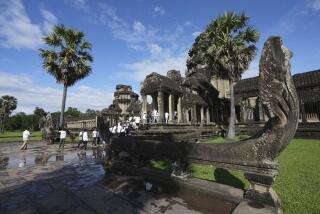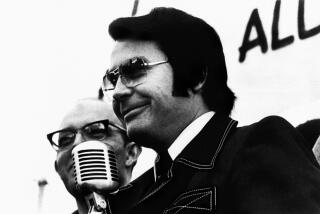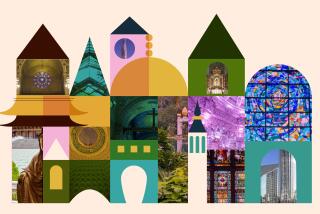AMERICAN ALBUM : A gilded palace with a skeleton in the closet : In the backwoods rises a monument for a swami, and a facade of harmony. But the Krishna vision grows.
- Share via
MOUNDSVILLE, W. Va. — In 1968, some California devotees of a Hindu spiritual master saw a newspaper ad calling for people to settle in an isolated but beautiful part of the Mountaineer State.
The acolytes set up a small farm, were joined by others and eventually formed a tightly knit religious community. In 1973, beginning with only a rough sketch on a piece of paper, they started building a home for Swami Prabhupada, their leader.
In 1977, the swami died at his palace. Two years later, his home was opened to the public.
Picture this: You’re jolting and jerking down four miles of narrow, barely paved asphalt road somewhere in the boonies near Wheeling. All of a sudden you round a curve and there it is: the domes of Prabhupada’s Palace of Gold, 8,000 opulently appointed square feet of marble, onyx, teak and gold leaf. It’s like stumbling upon the Taj Mahal in Garth Brooks country.
“We just wanted to build a small place for our spiritual leader,” said David Waterman (Hindu name Garga Rsa), who manages the palace. “Then we got a little carried away.”
Here’s how “carried away” they got: The 10 rooms of the palace include 31 stained-glass windows, 52 varieties of marble and onyx, carved teakwood furniture and doors, 8,000 square feet of gold leaf, four peacock windows handcrafted with 1,500 pieces of stained glass and crystal, enameled brass vases, numerous intricately painted murals, several massive crystal chandeliers and two life-size statues of the swami--at work in his apartment, which features a marble sink and toilet, and seated on his jewel-studded vyasasana , the seat of the spiritual leader.
All this at a cost of $800,000. You read that right: The labor used to build the palace was donated, as were many of the materials. The devotees learned construction techniques by reading do-it-yourself books.
And when the going got really tough, “the most difficult thing to understand was that we didn’t have the ability to build it, it was all coming from Krishna,” said P. K. Swami (birth name Phillip Jones), a spokesman for the New Vrindaban Community, of which the palace is the spiritual center.
New Vrindaban is a 200-member Hare Krishna outpost. There were once as many as 700 acolytes living here, but a mid-1980s split in the Hare Krishna movement caused many to leave the area.
Those who remained refer to themselves as American Krishnas, and, for the most part, do not have the shaved heads and topknots familiar to airport travelers and city dwellers.
Given the rural nature of the area--the community owns 3,500 acres, 300 of which are used as farm and dairy land--many of the devotees dress and look just like their working-class neighbors.
“We feel our philosophy and teachings are of benefit to people,” Swami said, “but if you’re turned off by shaved heads and weird clothes, you’ll never get to that point.”
Not that the Krishnas are just plain folks. Their religion bans liquor, tea, coffee, meat, fish, eggs, gambling and sex outside of marriage. They meditate for two hours daily and hold religious services as early as 4 a.m.
Many greet outsiders with “Hare Krishna,” the name of their Hindu deity. And they exhibit a calmness, a sense of being true believers, which is at once admirable and unnerving.
New Vrindaban also has one very large skeleton in its closet.
Kirtanananda Swami Bhaktipada (birth name Keith Ham), the disciple of Prabhupada who helped found the community, was convicted in 1991 on several counts of racketeering, mail fraud and conspiracy to commit murder.
Bhaktipada allegedly conspired in the 1986 California murder of Stephen Bryant, an outspoken critic of the sect.
Bhaktipada was sentenced to 30 years in prison and has retained famed attorney Alan M. Dershowitz to handle his appeal.
Despite this stain of violence, the palace and its environs do not have a Jim Jones’ People’s Temple aura. The 75,000 or more travelers who visit New Vrindaban annually (it’s a big hit with tour bus operators) see a bucolic, peaceful area of rolling hills and lush forests filled with hard-working, pleasant and devoted people.
Besides the palace itself, tourists can enjoy the 20 acres of grounds, which feature a garden with 1,000 varieties of roses. They can also eat in the beautifully appointed vegetarian restaurant, browse in the large gift shop and stroll around the two man-made lakes, which have massive statues of Hindu deities and a 25-foot-long gold-plated swan.
Yet even this opulence is only a beginning. Already under construction, but decades away from completion, is the City of God, a massive interfaith project.
Plans for the project include places of worship for all religions, which will surround a 300-foot-tall cathedral designed to accommodate as many as 10,000 pilgrims per day.
“The whole idea behind the City of God,” Swami said, “is that we have on this land a community of different religions living together as neighbors.”
Of course, no one’s figured out how they’re going to get all those people down that lousy road. But if past experience is any guide, the folks at New Vrindaban know the answer: Krishna will show the way.
More to Read
Sign up for The Wild
We’ll help you find the best places to hike, bike and run, as well as the perfect silent spots for meditation and yoga.
You may occasionally receive promotional content from the Los Angeles Times.






